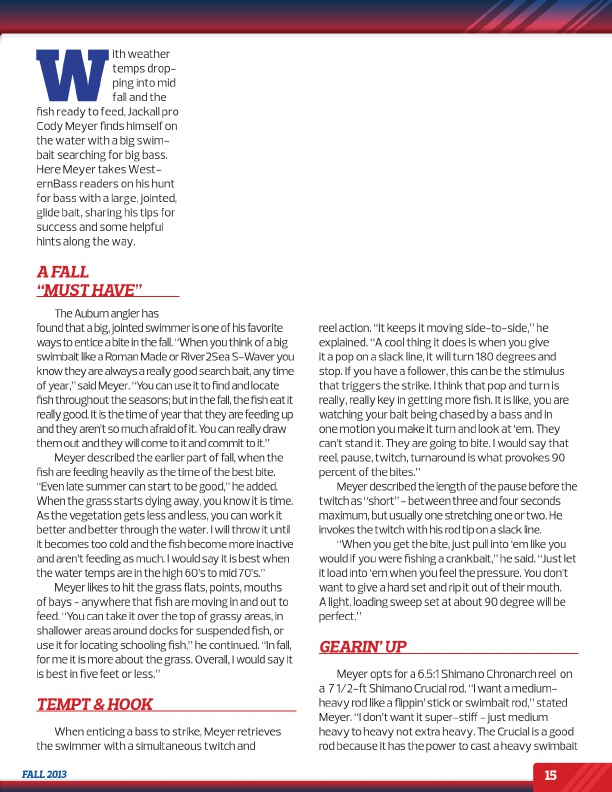
W
ith weather temps drop- ping into mid fall and the fish ready to feed, Jackall pro Cody Meyer finds himself on the water with a big swim- bait searching for big bass. Here Meyer takes West- ernBass readers on his hunt for bass with a large, jointed, glide bait, sharing his tips for success and some helpful hints along the way.
A FAll “MUst hAVe”
The auburn angler has found that a big, jointed swimmer is one of his favorite ways to entice a bite in the fall. “When you think of a big swimbait like a roman Made or river2Sea S-Waver you know they are always a really good search bait, any time of year,” said Meyer. “You can use it to find and locate fish throughout the seasons; but in the fall, the fish eat it really good. it is the time of year that they are feeding up and they aren’t so much afraid of it. You can really draw them out and they will come to it and commit to it.” Meyer described the earlier part of fall, when the fish are feeding heavily as the time of the best bite. “even late summer can start to be good,” he added. When the grass starts dying away, you know it is time. as the vegetation gets less and less, you can work it better and better through the water. i will throw it until it becomes too cold and the fish become more inactive and aren’t feeding as much. i would say it is best when the water temps are in the high 60’s to mid 70’s.” Meyer likes to hit the grass flats, points, mouths of bays - anywhere that fish are moving in and out to feed. “You can take it over the top of grassy areas, in shallower areas around docks for suspended fish, or use it for locating schooling fish,” he continued. “in fall, for me it is more about the grass. overall, i would say it is best in five feet or less.”
reel action. “it keeps it moving side-to-side,” he explained. “a cool thing it does is when you give it a pop on a slack line, it will turn 180 degrees and stop. if you have a follower, this can be the stimulus that triggers the strike. i think that pop and turn is really, really key in getting more fish. it is like, you are watching your bait being chased by a bass and in one motion you make it turn and look at ‘em. They can’t stand it. They are going to bite. i would say that reel, pause, twitch, turnaround is what provokes 90 percent of the bites.” Meyer described the length of the pause before the twitch as “short” - between three and four seconds maximum, but usually one stretching one or two. He invokes the twitch with his rod tip on a slack line. “When you get the bite, just pull into ‘em like you would if you were fishing a crankbait,” he said. “Just let it load into ‘em when you feel the pressure. You don’t want to give a hard set and rip it out of their mouth. a light, loading sweep set at about 90 degree will be perfect.”
geARin’ Up
Meyer opts for a 6.5:1 Shimano Chronarch reel on a 7 1/2-ft Shimano Crucial rod. “i want a medium- heavy rod like a flippin’ stick or swimbait rod,” stated Meyer. “i don’t want it super-stiff - just medium heavy to heavy not extra heavy. The Crucial is a good rod because it has the power to cast a heavy swimbait
teMpt & hOOK
When enticing a bass to strike, Meyer retrieves the swimmer with a simultaneous twitch and
fall 2013
15